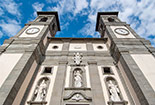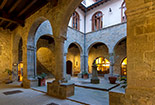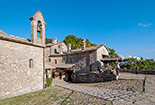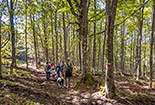Camaldoli, a hermitage and a monastery
in Casentino, a Tuscan valley with which you can get familiar in every detail through this site
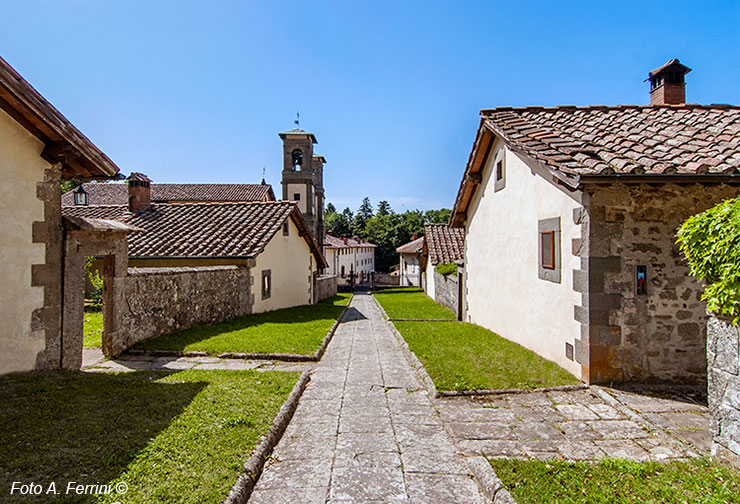
Texts and photos by Alessandro Ferrini ©
22 accurately described images of Camaldoli. Click to enlarge
Camaldoli: the Sacred Hermitage, the Monastery, the forest
IN Casentino the term Camaldoli IS used TO indicate a vast area inside the NATIONAL Park OF the Casentino Forests, rather than just a certain place. Two world-wide known places such AS Camaldoli Sacred Hermitage AND Monastery ARE part OF this territory, AND ARE nestled IN an incredible NATURAL environment FOR centuries known AS Camaldoli Forests: such NAME IS NOT due TO its proximity AT the two religious places, but mostly because they were created by the same Benedettini monks since their settlement IN this area over one thousand years ago.
 The NAME Camaldoli comes FROM Maldolo, a COUNT FROM Arezzo that, according TO the legend, gave TO Saint Romualdo, a Benedettino monk founder OF the Camaldolese Order, AND TO SOME OF his followers the territory ON which Camaldoli Hermitage was founded.
The NAME Camaldoli comes FROM Maldolo, a COUNT FROM Arezzo that, according TO the legend, gave TO Saint Romualdo, a Benedettino monk founder OF the Camaldolese Order, AND TO SOME OF his followers the territory ON which Camaldoli Hermitage was founded.
The official AND everywhere accepted DATE OF Camaldoli foundation IS the YEAR 1012; even though, several scholars have supposed the born OF this monastic center TO be dated back TO a later TIME because Teodaldo, the bishop FROM Arezzo that approved such foundation, was NOT present IN 1012 yet.
At that TIME, therefore, the monk Romualdo (born IN Ravenna around 952, died IN Fabriano IN 1027) that was already taking care OF several Benedettini hermitages, being IN the area OF Campo Amabile, a clearing AT a height OF 1100 meters ON the Tuscan slope OF the Tosco-Romagnolo apennines, decided, surely pushed by the bishop OF Arezzo, TO lay the foundations IN this place OF a new hermitage WITH a different "cut" FROM the Benedettini ones already present IN the nearby Romagna AS well. Therefore, the monk Romualdo, who later became a Saint, NOT ONLY founded a new hermitage, but also a new order: the Camaldolese one.
In the place that nowadays IS known AS Camaldoli Hermitage the above mentioned monk FROM Ravenna AND his followers built the FIRST five cells AND a small oratory that was dedicated TO Jesus' Transfiguration and consacrated by the bishop Teodaldo from Arezzo in 1027, year in which Romualdo died; he was then nominated Saint almost five centuries later in 1595. The hermitage expanded rapidly; while, the oratory, which had also been built with poor quality material, was quite soon found to be inappropriate. In the second decade of the 13th century its place was taken by a church, which in 1220 was consacrated by Cardinal Ugolino, belonging to the Conti Segni family, future Pope Gregorio IX. In the following centuries the church went through many restorative measures and structural modifications. In the second half of '600, because OF BOTH damages FROM a fire AND the aim OF adapting it TO the criterions OF that TIME, it underwent a REAL reconstruction WORK. This IS the reason why nowadays it shows IN its inside a strongly Baroque style WITH lots OF wood AND golden plasters, which IS ALL rather contrasting WITH the "hermit features" OF the rest OF the surroundings. Two important "not-Baroque" works OF art ARE kept IN this church: an Andrea della Robbia's glazed terracotta, dated back to the end of the 15th century, illustrating Virgin Mary with the Baby among Saint Romualdo and Saint Antonio Abate; and Agnolo di Cosimo di Mariano's (also named "The Bronzino") major altarpiece OF 1563 illustrating Jesus' Crucifixion among Saint Romualdo, Saint Peter, Saint Paul and Saint Francis. The church facade, which with its two great and particular twin bell-towers represents a unique symbol of Camaldoli Hermitage, was built at the beginning of the 18th century.
However, Camaldoli Hermitage is not just about its church. The first thing that will stike our attention while entering will be the "hermit area" (not accessible to the public, but clearly visible for the gate) with its many monks' cells well ordered, its straight paved boulevard that separates them, its majestic spruces dark crown ON the background that frames the whole SPACE ON the sky.
In the building IN front OF the church there IS a door that leads TO a sort OF tunnel. It IS the access TO Saint Romualdo's cell. It is a place to be visited with attention and silence, in order to be able to understand and feel the atmosphere that surrounds a  hermit monk's choice OF life, IN BOTH the Middle Ages AND nowadays.
hermit monk's choice OF life, IN BOTH the Middle Ages AND nowadays.
Sain Romualdo did NOT FOUND ONLY Camaldori Hermitage. A little MORE downward, IN the Fontebona area (such NAME IS due TO the presence OF a spring WITH copious AND high quality water), there was a disregarded structure, property OF the nearby Prataglia Abbey, which had been built a few years earlier, BETWEEN 985 AND 990, still ON a plot OF land donated by COUNT Maldolo. Romualdo rearranged this building WHERE other monks, who must have had very different functions FROM the ones that inhabitated the hermitage, were placed. IN this CASE it was important a continuous contact WITH people AND the structure, AT that TIME modest, which was also used AS lodging FOR pilgrims AND wayfarers. Over the years, the decades, the centuries this monastic complex enormously expanded untill IN the 16th century it became that great structure today known AS Camaldoli Monastery.
Besides the huge AND austere monastic complex IN its totality, there ARE other things that need TO be seen: the INNER cloisters, particularly the FIRST one, Mandolo's one that takes its name from the donor count of the plots of land in which both hermitage and monastery are found; the fascinating locations of the ancient pharmacy where it is possible to purchase the well-known monks' products; AND the church dedicated TO Saint Donato AND Saint Ilariano. This church, several times rebuilt over the years, (LAST TIME IN the SECOND half OF the 18th century) presents a Baroque style inside AND it IS embellished by five tables AND two "predellas" OF the great architect AND painter Giorgio Vasari FROM Arezzo. Such works OF art had been painted by the artist FOR the previous church built AT the beginning ot the 16th century.
Camaldoli Sacred Hermitage AND Monastery have much MORE TO show: places OF immense charm AND high historic, cultural AND artistic VALUE AS the monks' refectory, the Monastery seclusion, and the Sacred Hermitage ancient library. Places that unfortunately are not open to the public, but accessible only because of studying reasons. However, this web section can show them through in detail illustrated images.
Camaldoli, as metioned in the beginning, is also "synonime" of charming and uncontaminated nature. In fact, it is located in "hearth" of the National Park of the Casentino Forests. In this area it is possible to perform demanding excursions or relaxing walks that lead us through centuries-old forests of spruce and beech trees to mountain grasslands and places that offer breath-taking views.
Untill here we have talked about Camaldoli as an historic, artistic and naturalistic place. But Camaldoli is first of all a place of "faith". From this point of view, it is not only known in Casentino and bordering lands, but also in Tuscany, in Italy and beyond. Here, beside the usual religious functions, are periodically held meetings, conferences, recreational moments in order to strengthen our own interiority (for the program of such activities and many other pieces of informations about this place visit www.camaldoli.it).
indirizzato al trekking, o semplicemente quello che ti fa staccare dalla vita frenetica delle citt?.  Camaldoli is also open to hosting tourists for either religious or other purposes. The Sacred Hermitage can host about twenty people in very simple bedrooms provided with only the essentials. Someone who wants an intense detachment from everyday's life comes TO spend a few days IN this place, losing themselves IN nature AND IN the monks' hermit spirit, alternating moments that are meant to be rigorously experienced just by ourselves and other moments of sharing with the monks and the other guests. The Monastery guest house can host 170 people. Here comes people that enjoy several types of tourism. The religious one for sure, but also the one related to trekking, or simply the one that allows us to detach from the chaotic life of the cities. Turists devoted to art or that "lay their basis" here in order to first visit Camaldoli, but then also the many other beauties that the Casentino valley offers.
Camaldoli is also open to hosting tourists for either religious or other purposes. The Sacred Hermitage can host about twenty people in very simple bedrooms provided with only the essentials. Someone who wants an intense detachment from everyday's life comes TO spend a few days IN this place, losing themselves IN nature AND IN the monks' hermit spirit, alternating moments that are meant to be rigorously experienced just by ourselves and other moments of sharing with the monks and the other guests. The Monastery guest house can host 170 people. Here comes people that enjoy several types of tourism. The religious one for sure, but also the one related to trekking, or simply the one that allows us to detach from the chaotic life of the cities. Turists devoted to art or that "lay their basis" here in order to first visit Camaldoli, but then also the many other beauties that the Casentino valley offers.
In Casentino, near Soci, is located the "Mausolea": a magnificient seventeenth-century villa owned by the Camaldolesi monks that was restored in 2007. Here as well, in a large and elegant room, meetings and conferences are held. However, Villa Mausolea could also be defined Camaldoli "agricultural branch". Here, in fact, an excellent wine is producted in the ancient cellars, where we can still admire enormous barrels of the '700. The grapes used FOR the making OF this wine IS grown IN nearby vineyards, still owned by the Camaldolesi. The wines produced ARE: Red AND White Borbotto, a "vinsanto" called Borbotto Passito, AND, show-piece OF the Camaldolese wine production, the Musileo. A liqueur wine obtained FROM a tardive grape harvest USING grapes that ARE already partially dehydrated still ON the grapevine AND partially covered by healthy mildews brought by the humidity that characterises November. These wines can be purchased directly by Villa Mausolea during the opening days, by Camaldoli Monastery pharmacy, by the Sacred Hermitage small shop, AND by many shops IN Casentino that sell typical products OF this Tuscan valley.



